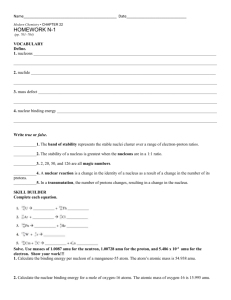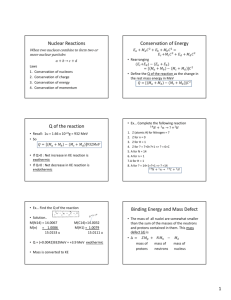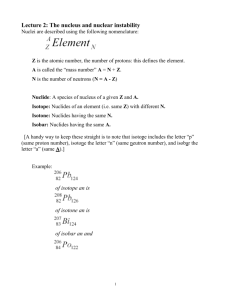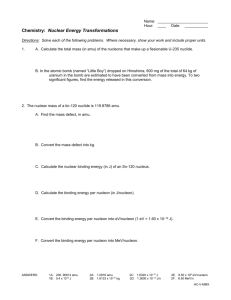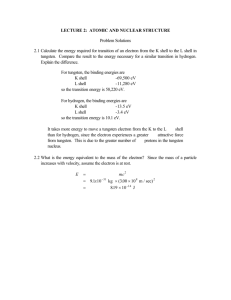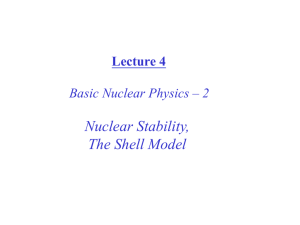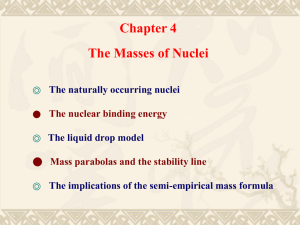3 Nuclear Stability & binding energy use
advertisement
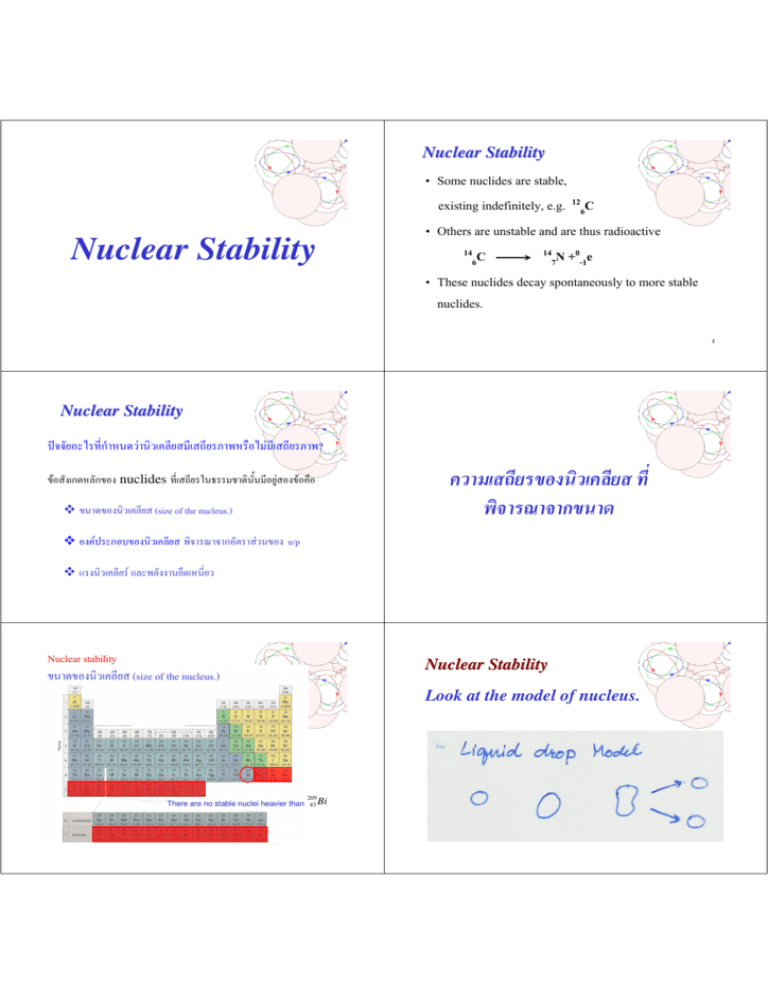
Nuclear Stability Some nuclides are stable, existing indefinitely, e.g. 126C Others are unstable and are thus radioactive 14 C 14 N +0 e 6 7 -1 These nuclides decay spontaneously to more stable nuclides. Nuclear Stability 2 Nuclear Stability !"#$%&'()*+,-./*,0.123& 45&146& $7*8+$9!#5/5&146& $7*8? ;<!4=1(>+3(;!= nuclides %&'146& $?,@$$5A*>0,B,5&! C/4!=;<!29! ;,*-;!=,0.123& 4 (size of the nucleus.) !=2H$"(!I;!=,0.123& 4 80*$J**(!>$*4/.,;!= n/p L$=,0.123& $H L3"83==*, M-1+,&' . Nuclear stability ;,*-;!=,0.123& 4 (size of the nucleus.) Nuclear Stability Look at the model of nucleus. There are no stable nuclei heavier than 209 83 Bi Shell model !"#$%! !&'&()&*+,-)&$'./$) 8I./* 5&)*,.,,0.23&!!,%&'! C/?,,0.123& 4%&'5&2.*5146& $4C= %&'1$& (./* Magic numbers are nuclei %&'5&2/*1%/*(I 2, 8, 20, 28, 50, L3" 82 4)*+$I protons +$9! 2, 8, 20, 28, 50, 82, L3" 126 4)*+$I neutrons 23<* (I(*$-1$& =!0132>$!,.=,!(%&'5&2.*5146& $4C= ?,!">!5;!=(V*W1X9'! ( 2, 8, 18 , 32) =8I./* ,0.123& 4%&'5&)*,., protons +$9! neutrons 1Z,13;2C/ 5& 2.*5146& $5*((./* ,0.#23-H%&'5&)*,.,,0.23&!!,1Z,13;2&' 1A/, 4 He 146& $(./* 3 He 2 2 7 • magic numbers 0 12 &&3)(/)4$&$'. • !&%54!)& 6&0 7*&) %8 !!&%54!)&/ $)!&91 1Z,LII)*3!=;!=,0.123& 4%&'$.5L,.2.*520;!= liquid drop model 1;<*(I shell model 9 !>$*4/.,;!= n/p =1:1 n/p *(($*^ $"+./*= n/p ;!= )*,.,,0.#23-H%B=+5- 2000 ,0.#23-H 8I./*5&,0.#23-H%&' 146& $ 18& = 279 ,0.#23-H. ?,@*>a+,(!>$*4/.,;!= n/p >1 %)*?+<14<,2.*5146& $1(0-(*$ 1I&' =1I,*(14<, n/p %&' = 1 Patterns of Nuclear Stability .&# NeutronNeutron-toto-Proton Ratio • 7*&) *+3:12*&$3! $54&4!/&#(!&!4 '7*&)8&;!1<==>&$64!4&3& • &12'8'5'7*&)/6%54&4!<'% &!4 &&9 • 3:)&12<4*&$3<==>*+9*&$! $?5!'8'5'<%'% &&,4'!7*&) • /@)36!7*&)!8&;!!(4!8 • @)36!8)%!&)&!.02/6%?&:.7'!&'& ;!&$647*&) 15 Mass too high α decay. N/Z too high β- decay. N/Z too low β+ decay or electron capture. Patterns of Nuclear Stability Nuclear Stability NeutronNeutron-toto-Proton Ratio E.g. Here is how the 238U decay sequence looks on our zone of stability graph. • @*>a%&'5&2/* Z > 83 1Z,,0. #23-H%&'#5/146& $%a(@*>a c4* >.?+<$=4&L!3^d* 189'!3)*,.,c$>!, 2 +,/. L3" ,0.>$!, 2 +,/. ?,(*$ 43* >.2$B=1-& .L3"43* >. ?+<$=4&A,0-!9',e189'!3!>$*4/.,;!= n/p ?+<1;<*?(3< 1:1 5*(%&'4a19 Patterns of Nuclear Stability Patterns of Nuclear Stability NeutronNeutron-toto-Proton Ratio NeutronNeutron-toto-Proton Ratio • <'9 12)64)2!4 %7%?& )/6% & β+ 12*+ 3:$*&$314 )& )4*&$3*+! 81/6%7*&)'1 64 $)&.28 1 64 6&0!'!!& )&,/3' %<* &/ &!4 “electron captureJ • <'9 12)645!4 %7%?&) /6% & β 12*+ )& &(5 81/6% 7*&).28 1 64 $ )&' 1 64 21 !" Nuclear Equations • In nuclear equations to ensure conservation of nucleons we write all particles with their atomic and mass numbers: Nucleons /!'!&)<'%': 1 0n → 11p+ + 0-1e- (β β-emission) 0 -1e -+0 1 1 0 p+ 1 p+ 1e + → 0n + + 0 -1 238 U 92 → 200γ (positron annihilation) 1 e- 0 + 1e (positron or 22 4 2α → 23490Th + 42α represent for nucleus 42He (α α-radiation) β+-emission) • In nuclear equations, the total number of nucleons is conserved: 1 → 0n (electron capture) )*,.,,0.23&!!,%B=4!=;<*=1%/*(, • Energy is conserved 23 24 # " Nuclear force # " #$%& 1Z,L$=$" "4B,1(0-;MB,?,I$01.J13f(e?,,0.123& 4 1Z,L$=%&'5&;,*-5*((./*L$=g3(;!=$"a#^^h* 1Z,L$=%&'5&;,*-5+*i*3 1(0-*(*$8$/!=;!=5.3 (mass defect) L3<.13&' ,#1Z,83==*, The Einstein Equation '" $&#$ !&*2*. (∆ ∆ E) /!&$!&!' !&&)!*+ 1/6%!'!&..02/,%/!&8'62 211p + 210n &#<'%!!&*2*126<* (∆ ∆ m; mass defect )&$64;):#W9$&))%7.@9!)!& 4 He (E = -∆ B ∆E) 2 ∆E = ∆mc2 m = c = &(/5X!Y (3x108m/sec) 27 Calculating “ Mass Defects” 28 6& n+p %)*#-<c- ?A<+*5.3$.5;!= p+n L3<. ,)*5*+*g3>/*=c- 3I-<. 5.3$0=;!=,0.#23-H,B, = (3 × mass of p) + (4× × mass of n) mass of proton = 1.00728 amu mass of neutron = 1.00866 amu )4 !&6 ∆m 73Li 12 7.016004 amu +*)*,.,,0.>$!,*( n = A-Z 7 Li 5& neutrons = 7-3 = 4 3 6;)4!&<'9 ∆m = (mass of p + n) - (atomic mass of nucleus) 29 30 What is the mass defect in formation of a 42 He nucleus? <'% mass of p + n = 3(1.00728) + 4(1.00866) = 3.02184+4.03464 = 7.05648 amu (Mass of He nucleus (measured) = 4.00153 amu) ,4#/6%&9'%!!! ∆m = m[42He] - 2m[11H]-2m[10n] = -0.03035 amu mass defect of nucleus = 7.05648 - 7.016004 ∆m = 0.040476 amu 31 Binding Energy (∆E) 32 The Electron Volt ( eV ) ∆E = ∆mc2 7' m 64*+ kg $ &( c ' 64*+ ms-1 4 He 211p + 210n 2 ∆E = -28.2956 MeV 6&0 ∆E = -4.53*10-12 J = -2.73*1012 J/mol $<'%./64 5 (J) (1J = 1 kgms-1) 6&0/,% 1 amu = 931.5 MeV 12$'!$!!4 Note 1 MeV = 1.602177*10-13 J 34 Sample Problem Energy Changes /!&!' 42He !&*2 *. -28.2956 MeV 6&0 -2.73*1012 J/mol o82!!4.12<'%!*p!&12<*?8 %14 ( ~107 14) &&98*+&12' 6Y 35 Calculate the binding energy per nucleon for the isotopic species 3517Cl (mass 34.96885 amu.) • Step 1 - write balanced nuclear equation. • Step 2 - determine mass defect ...m. • Step 3 - convert ∆m to ∆E (1 amu = 931.494 MeV) • Step 4 - convert ∆E to Eb ( sign change ) and divide by the number of nucleons in the nucleus. 36 Cl-35 nuclear binding energy 12'/6X48 ?&8&6&0??? = 4.900 x 10-11 J/atom 6&0 = 2.951 x 1013 J/mol .&#!!' ! 4.8'62 .402' /6X48.8'62!(2!8 !? There are no stable nuclei heavier than 209 83 Bi Binding Energy Per Nucleon 39 Some of the binding energies per nucleon for some common elements Element Deuterium Helium Lithium Beryllium Iron Silver Iodine Lead Polonium Uranium Uranium Neucleon number 4 7 9 56 107 127 206 210 235 238 Mass of nucleons 2.01594 4.03188 7.05649 9.07243 56.44913 107.86187 128.02684 207.67109 211.70297 236.90849 239.93448 Nuclear mass 2.01355 4.00151 7.01336 9.00999 55.92069 106.8793 126.8754 205.9295 209.9368 234.9935 238.0004 Eb (MeV) 2.23 28.29 40.15 58.13 492.24 915.23 1072.53 1622.27 1645.16 1783.8 1801.63 To compare nuclear stabilities, need to look at binding energy per nucleon. 4 He 2 Eb = 28.2956 MeV Eb/4 = 7.0739 MeV 35 Cl 17 Eb = 298.2085 MeV Eb/17 = 17.5468 MeV This figure gives a direct measure of the stability of the He nucleus. 40 Trends of Binding Energy in Nuclear Stability Eb per nucleon (MeV) 1.12 7.07 5.74 6.46 8.79 8.55 8.45 7.88 7.83 7.59 7.57 41 42 • Binding energy per nucleon initially increases with atomic mass. • Maximum stability is reached in the vicinty of 56Fe, which has Eb/A = 8.8 MeV. • Stability decreases slightly for successively heavier elements. 43

